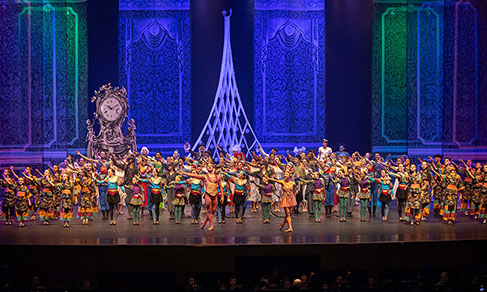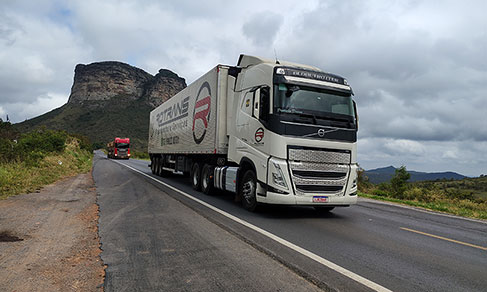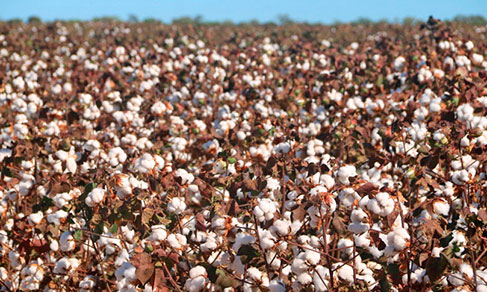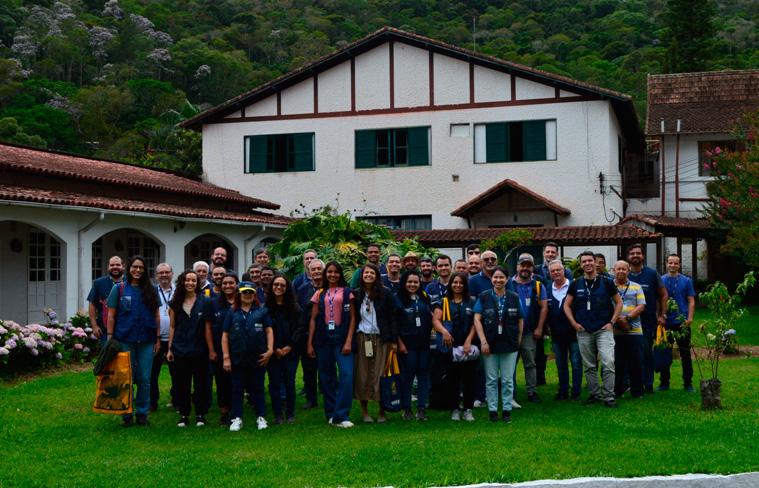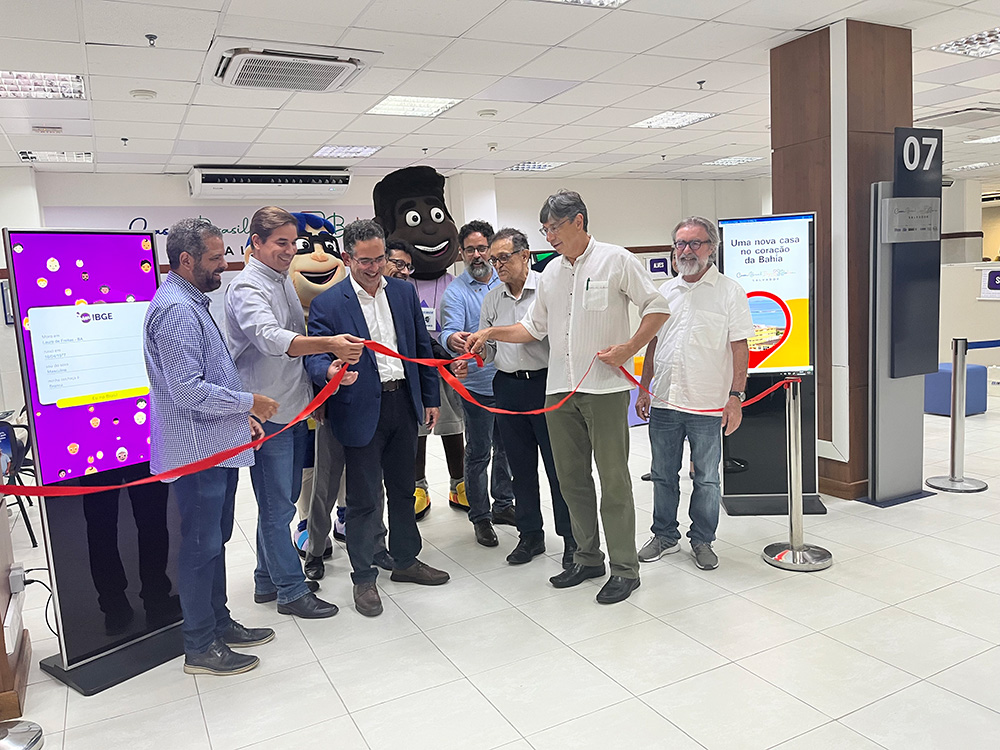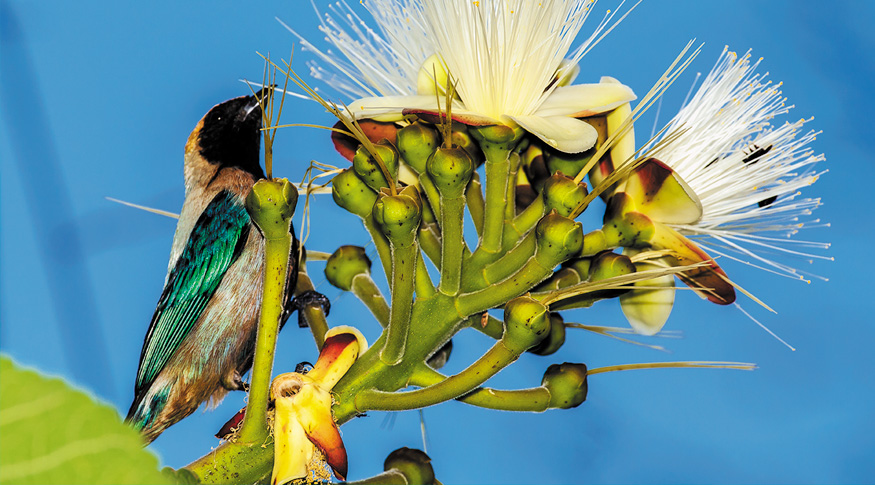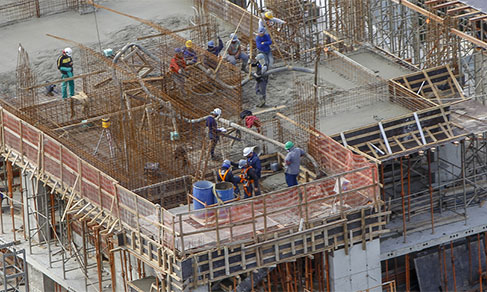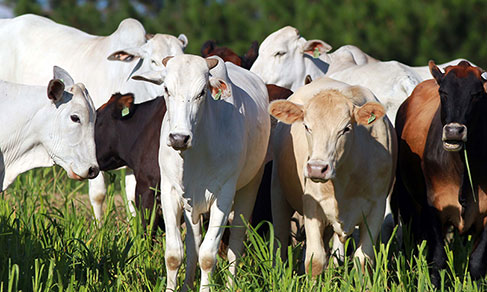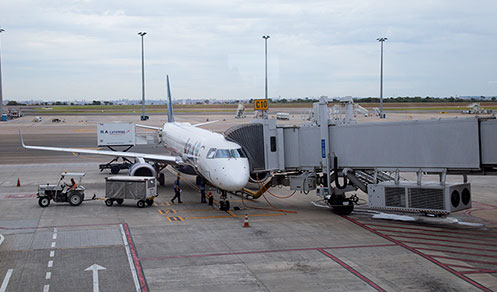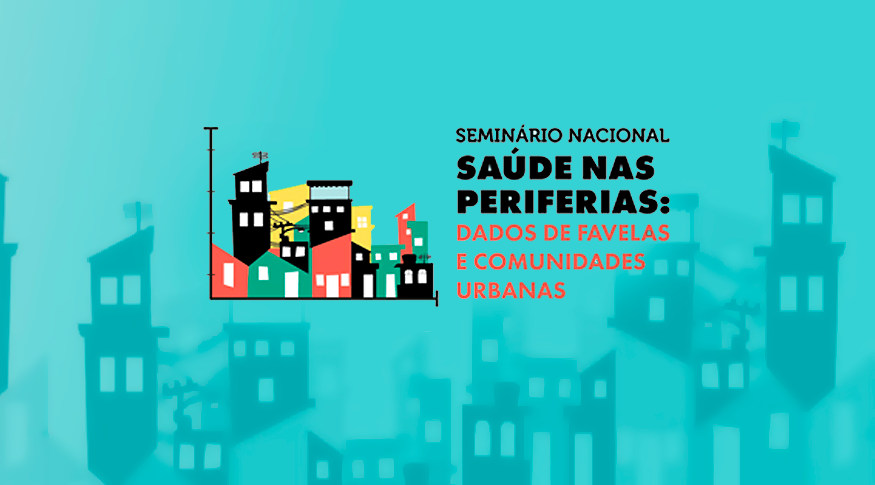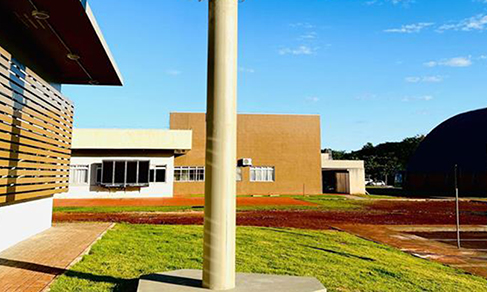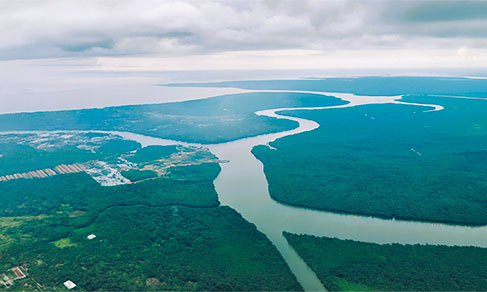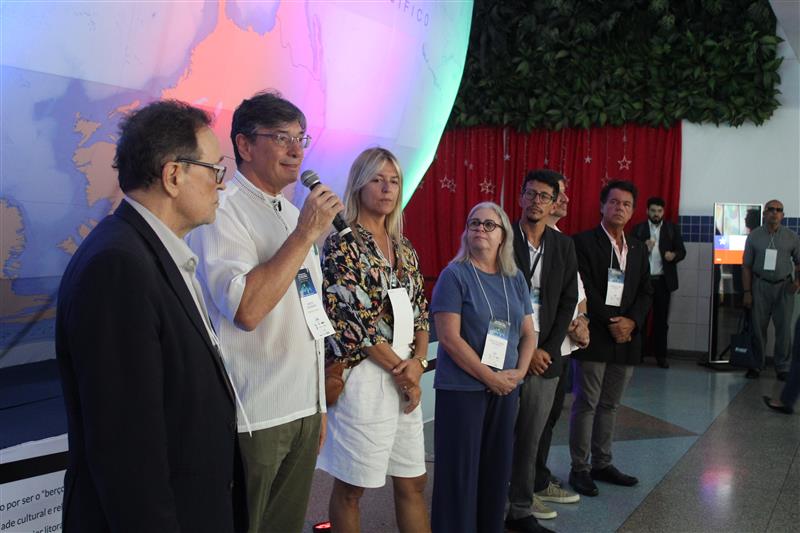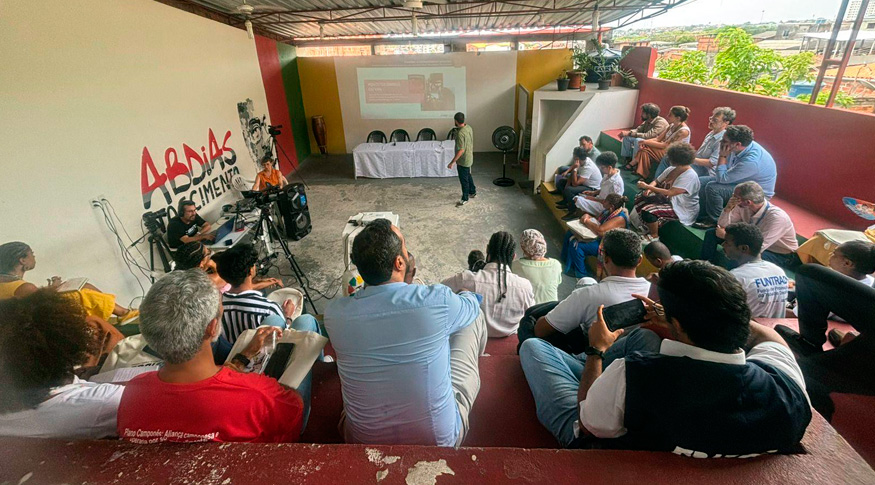Profile of the Brazilian States
ESTADIC 2024: Three states did not have a channel for citizens to report violation of racial rights
October 31, 2025 10h00 AM | Last Updated: November 04, 2025 03h58 PM
Highlights
- Brazil had 24 states with a specific structure to receive, register and monitor reports of violation of ethnic and racial rights in 2024. Acre, Tocantins and Sergipe did not an available structure to receive this type of report.
- In all the 27 states, the office in charge of the Racial Equality Promotion Policy had programs and actions aimed at the Black Population and at Traditional Peoples and Communities of African Descent or People of Terreiros (places of worship). Nevertheless, Gypsies, Indigenous persons, Quilombola persons and other Traditional Peoples and Communities were not included in these programs and actions in some states.
- Only Rio Grande do Norte and Paraná had a Racial Equality fund in 2024; other six received funds from the Union and/or from private entities.
- Eight states had no vacancies in public competitite examinantions reserved for the black, Quilombola, Indigenous or Gypsy populations in 2024.
- The website (24) and telephone (22) were the most common common service channels among state governments, but the Whatsapp was already being used in other 19.
- Internal control offices of 26 states had the function of a Comptroller or worked in the Promotion of Integrity/Fight Against Corruption in 2024.
- The number of states with a registry or list of families interested in Housing Programs was the lowest since 2017.
- The number of states providing the service known as "social rent" fell from 17 to between 2020 and 2024. In this period, Bahia, Paraná and Santa Catarina stopped offering this benefit, whereas Mato Grosso and Goiás started to do it.
- Among the 10 states with an intercity train or subway service, less than half had a fleet entirely adapted to persons with disabilities.
- Prevention Programs or Actions against Climate Problems in the Agricultural Sector were present in 24 Federation Units, versus 21 in 2020. Pará and Distrito Federal did not have any and Rondônia did not report its existence.
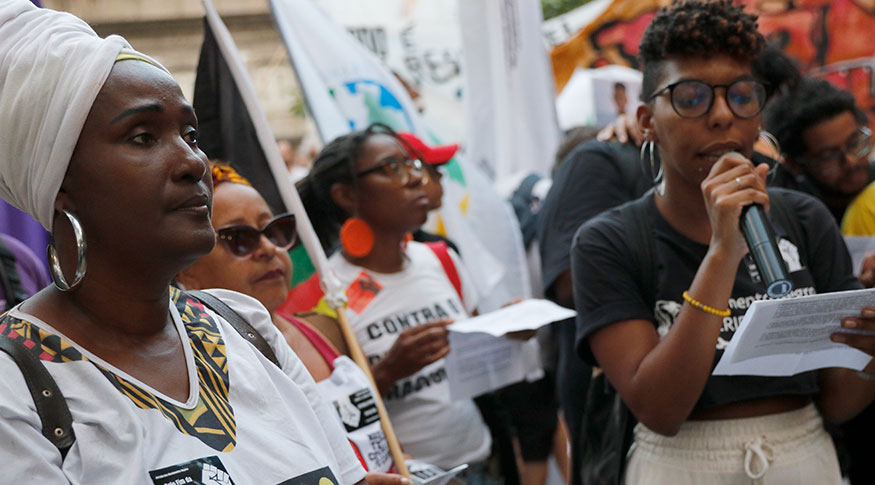
Of the 27 Federation Units (UF) in the country, 24 had a structure to receive, register and monitor reports of violation of ethnic-racial rights in 2024. An Ombdusman for Human Rights and/or councils, committees, citizenship commissions or the like were the most often mentioned offices receiving these reports, present in 14 states. Acre, Tocantins and Sergipe did not have a structure to receive this type of report.
Other 17 states had a Racial and Religious Crimes Police Station or similar agency in the capital. In Sergipe, Minas Gerais, Rio de Janeiro and Paraná also had this structure in other municipalities.
The data, released today (31) by the IBGE, are part of the Survey of Basic State Information (ESTADIC) 2024, which investigated, for the first time, the political and administrative structure of Racial Equality in the 27 Federation Units of Brazil. The survey also presents information about other six topics: Human Resources; Copmputer Science and Communication; Governance; Housing; Transportation and urban Mobility; and Agriculture. The IBGE also released today the Survey of Basic Municipal Information (MUNIC) 2024.
The manager of IBGE’s Social Indicators Surveys, Vânia Pacheco, explains that the absence of a channel for the report of violation of ethnic-racial rights in three states does not mean these localities do not receive reports. “Racial equality is a cross-cutting policy, so these states can offer other report channels, although they are not exclusive for the report of such violations.”
In the 27 FUs, the office in charge of the Racial Equality Promotion Policy developed programs and actions for the Black Population and for Traditional People and Communities of African Descent or People of Terreiros.
Nevertheless, the following population groups were not included in programs and actions promoted by the office responsible for racial equality policies in some states:
- Gypsies (Acre, Pará, Roraima, Tocantins, Rio de Janeiro and Rio Grande do Sul);
- Indigenous persons (Acre, Pará, Ceará, Maranhão, Mato Grosso do Sul, São Paulo);
- Quilombola persons (Acre);
- Other Traditional Peoples and Communities (Pará, Ceará, Maranhão, Pernambuco, Rio Grande do Norte, Mato Grosso do Sul, Rio Grande do Sul).
“It is important to highlight that social assistance, for example, serves this population even so. What the survey shows is that states do not have specific actions aimed at certain population groups. Racial Equality is something recent. As this type of policy is implemented by the federal government, states and municipalities can replicate it,”, Vânia Pacheco analyzes.
Racial equality managers are white in 11 states; black, in nine, and brown, in five states
As for color or race of Racial Equality Promotion managers, white people were the majority (11), followed by black (9), brown (5), Indigenous (1) and quilombola (1) managers. Minas Gerais did not report the color/race of the manager. Women were the majority (24), except for the states of São Paulo, Rio Grande do Sul and Goiás. This result is different from the other areas surveyed, where the service was mostly managed by men: Transportation (25 men and 1 woman, Rondônia, not reported), Agriculture (24 men and 2 women, Rondônia, not reported) and Housing (18 men and 9 women).
The manager of IBGE’s Survey of Social Indicators analyzes what can contribute to the increased presence of women in Racial Equality management, in comparison with the other topics surveyed. “In general, women are more dedicated to the debate of social issues. But there is still a long way to go, for, in Housing, which is also part of a social agenda, they represent only one third of the management positions,” Vânia explains.
The survey also shows that the 27 Federation Units had specific structures for management of Racial Equality Promotion in 2024, all of them directly linked to the state’s administration. All of them had a State Council for Racial Equality, except for Rio Grande do Sul. Bahia, Rio de Janeiro, Paraná, Santa Catarina and Mato Grosso had a Council for Traditional Peoples and Communities. These states held at least one meeting in the 12 months preceding the survey. The Council of Traditional Peoples and Communities that of African Descent and People of Terreiros were found in Rio Grande do Sul, although they did not have aby meeting in the 12 months preceding the survey.
In relation to the existence of a Committee of Comission for Racial Equality, 16 Federation Units had at least one of them in 2024. The most common committee was Health of the Black Population (8). Tocantins and Ceará, in spite of their committees or commissions, did not have any meeting in the 12 months preceding the survey. There were committees or commissions for Afrotourism and Ethnic or Tourism, Recognition, Protection ad Preservation of Gypsy Peoples’ Cultural Heritage.
Rondônia and Santa Cataria were the only state without a specific law for topics related to Racial Equality. The other Federation Units had, at least, one of the topics as a specific law. Among the legislation investigated, the most commonly mentioned ones were promotion of racial equality and/or fight against racism (20); vacancies in competitive examinations reserved for black persons (15); and fight against racial discrimination in the realm of public administration (14). The State Plan for Racial Equality was found in 9 Federation Units, and it was being developed in other 10. In São Paulo, the plan was not regulated by means of a legal instrument.
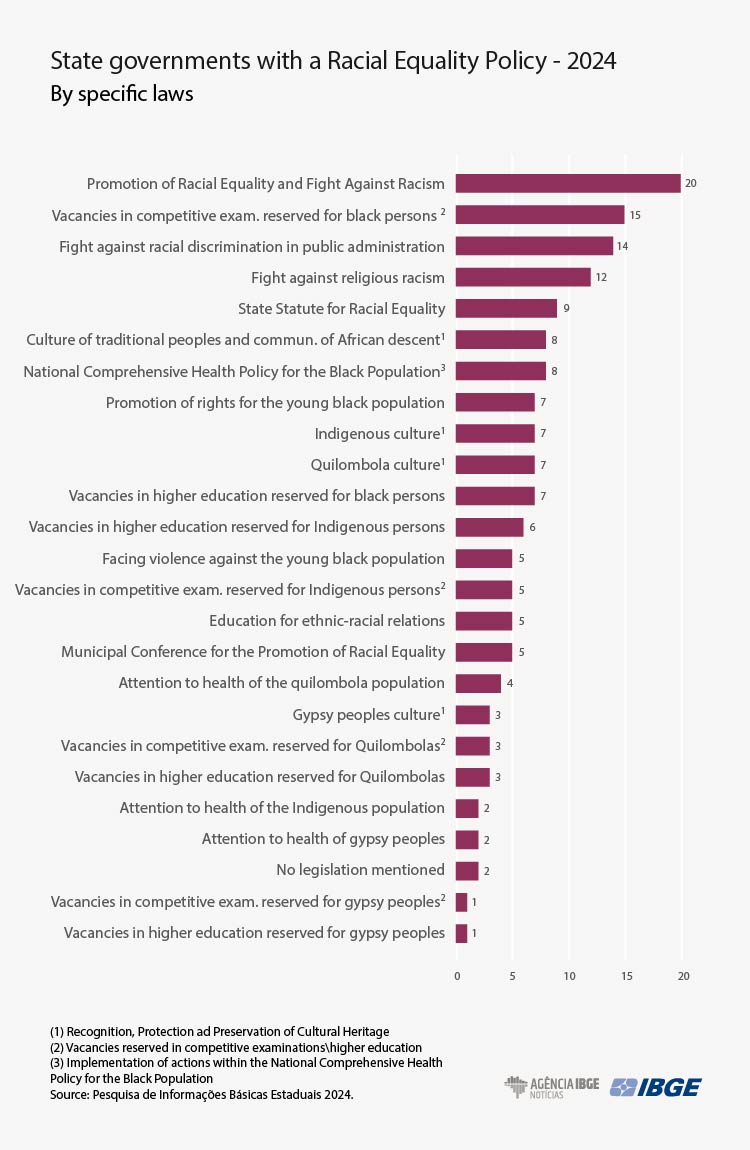
Only two states have a Racial Equality Fund; six received funds from the Union and/or private entities
Only Rio Grande do Norte and Paraná had a Racial Equality State Fund, but only in the former was the fund managed by the State Council. In Rio Grande do Norte, the Fund gathered all the budgets from other sources aimed at the Racial Equality Promotion Policy. In Paraná, the Fund was not managed by the Council and did not have all the budget resources aimed at the respective policy. The origin of budget resources of the Fund came from the state itself in Rio Grande do Norte and Paraná.
The 25 Federation Units without the Fund and Paraná, whose Fund did not gather all the budgetary resources aimed at the racial equality promotion, used the state’s own resources. In six Federation Units, besides the State resource, there were funds from the Union and/or private national bodies/entities.
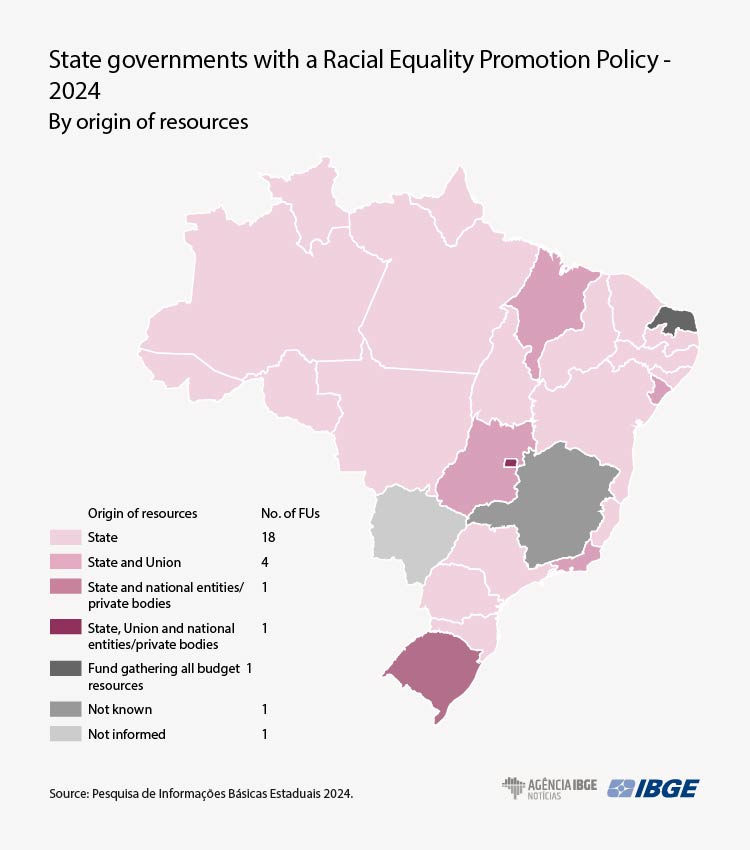
The state budget included the Racial Equality Promotion Policy for 2024 in eight Federation Units (Amapá, Rio Grande do Norte, Pernambuco, Alagoas, Espírito Santo, Paraná, Mato Grosso and Distrito Federal). However, none of them executed 100% of the expected budget.
Eight states had no reserved vacancies for blacks, Quilombolas, Indigenous persons and gypsies in competitive examinations
Amazonas, Roraima, Pará, Tocantins, Pernambuco, Minas Gerais, Santa Catarina and Goiás did not have reserved vacancies for black people, Quilombolas, Indigenous persons and gypsies in competitive examinations held in 2024. Another 14 Federation Units, in contrast, included reserved vacancies by means of public notice.
The state administration hired employees in 26 FUs, with 22 hiring people by means of competitive examinations. Ceará is an exception, for it did not provide answers about civil servants by colo/race, competitive examinations and reserved vacancies in Human Resources. Rondônia, Maranhão, Rio Grande do Norte and Paraíba did not organize examinations in 2024.
The number of employed persons employed in direct and indirect state administration, in 2024, was 3,076,223 and, in 2023, 2,986,198, which corresponds to an increase of 3.0%. The proportion of civil servants in direct state administration represented 87.4% (2,687,979) of the total, whereas indirect administration accounted for 12.6% (388,244).
Website (24) and telephone (22) are still the most commonly used channels among state governments, but the Whatsapp is already used in 19 of them
The most recurrent distance communication channles provided by state governments in 024 were a web page and telephone, found in 24 and 22 Federation Units, respectively. The Whatsapp, included in the survey for for the first time, was used in 19 FUs as service channels aimed at citizens.
The 27 Federation Units had state governments pages on the Internet, and in 24 of them it was possible to search case files and access the online police station. Scheduling medical appointments and exams at public healthcare facilities via state government website was possible in 10 FUs (versus 3 in 2019). Issuing tax payment slips or other payment forms via mobile phone was a service available in 18 Brazilian FUs.
The most frequently used digital platforms were YouTube and Instagram, used by state governments in all the FUs, followed by 26 states, except for Acre. Between 2019 and 2024, the number of Federation Units that had a WhatsApp account increased from 11 to 20. Tik Tok, surveyed for the first time, was found in 18 states in 2024. The use of these platforms for public consultations or enquiries also increased among the UFs, with a change from 7 in 2019 to 18 in 2024. Almost all the state governments (24) updated the content of platforms daily, except for Piauí and Goiás, which updated theirs at least once a week. Pernambuco did not provide information of periodicity.
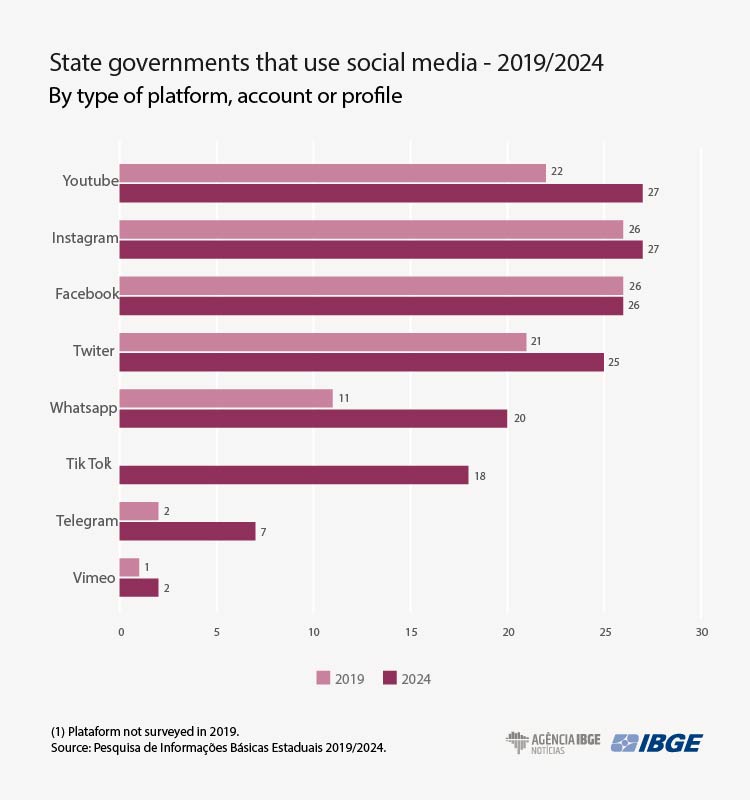
Almost all the state governments (26) (except for Alagoas) had a website adapted for mobile telephones or designed into a mobile version, whereas this functionality was present in 19 Federation Units in 2019. Except for Paraíba, the websites of state governments had accessibility, an improvement from 2019 (18). Translation of the content into LIBRAS (Brazilian Sign Language) was a functionality available in the websites of 17 states, with a significant increase from 2019 (5).
The unified travel pass, a technology for integrated access to public Transportation, was available in 12 Federation Units, an increase from 2019 (5). All the actions aimed at innovation and creativity recorded increase among the states: maintenance of innovation, coworking facilities or shared work facilities for micro and small-sized companies went from 13 in 2019 to 21 in 2024; training in digital entrepreneurship doubled, from 12 to 24; the establishment (alone or in partnership) and award or call for proposals to allocate resources to innovative companies/creative projects, increased from 19 para 21.
Internal control offices in 26 states perform the functions of Comptroller and Promotion of Integrity/Fight Against Corruption
All the Brazilian Federation Units had an organizational structure for internal control in 2024, except for Rondônia, which did not respond to the Governance section of the survey. Among the main functions of the state internal control system were: Comptroller and Promotion of Integrity/Fight Against Corruption (26), with an increase from 2019 (23); Government Audit (24), with a decrease compared to 2019 (27); Ombudsman (21), which remained the same as in 2019 (21); and Internal Affairs Office (19), which decreased against 2019 (20).
In all the 26 Federation Units, the state governments made internal control information available online. The most frequently available information, made available in 25 states, referred to the administrative structure of the internal control office, repeating the result of 2019. Nine FUs made public information on consultations regarding government performance indicators (against 4 in 2019), and 17 allow consultations on the monitoring of complaints (versus 14 in 2019).
Instances of social participation, such as Transparency Councils or similar bodies, became present in 14 Federation Units, versus 10 in 2019. However, in only 9 FUs did the Transparency Councils have meetings in the 12 months prior to the survey.
In 2024, 23 states published files in a user-friendly format
More state governments began making files available in user-friendly formats (csv, ods, xls, and doc) in 2024, compared to 2019. Among the file types are expense reports, found in a more user-friendly format in 23 states in 2024, against 21 in 2019; revenue reports, in 23, against 20; budget reports, in 17, versus 9; employee remuneration and subsidies reports, in 23, versus 17; procurement and bidding reports, in 20, against 15; balance sheets, in 10, versus 8; and accountability reports under the Fiscal Responsibility Law, in 9, compared to 5. There was a drop in the publication of general data in PDF or image formats, indicating a migration towards publishing information in a more user-friendly format.
The 26 Federation Units that reported information regarding Governance (except Rondônia) had specific state laws on procedures and measures to guarantee the right of access to information, in accordance with the LAI (Brazilian Access to Information Law). However, there were some setbacks in the content of the legislation from 2019. For example, the legislation of Acre and Rio Grande do Norte did not establish response deadlines, and that of Piauí and Rio Grande do Norte did not institute procedures for classifying confidential information. In 2019, there were no states that addressed both issues.
All the 26 participating Federation Units provided physical or virtual means for access to public information. The Citizen Information Service (SIC) was mentioned in 25 of them, against 26 in 2019, and 11 in 2014. Of the 26 states that responded regarding budget and financial execution, 24 (except Tocantins and Mato Grosso) did so in real time and by means of transparency portals.
For the first time, ESTADIC surveyed the state-level structure regarding the implementation of the General Data Protection Law (LGPD). In 2024, 23 Federation Units had an area or person responsible for procedures and policies for the collection, storage, and use of personal data or for the implementation of LGPD guidelines. Roraima and Mato Grosso did not, Rondônia did not provide information, and Bahia was unaware of the situation.
All these 23 Federation Units (UFs) offered online channels for citizens to submit messages regarding the use of their data; 18 provided training courses for their employees on information security; and 18 had specific state laws regarding the LGPD (Brazilian General Data Protection Law).
Number of states with a registry or list of families interested in Housing Programs is the lowest since 2017
A registration or list of families interested in housing programs was found in 18 states, a lower figure than that found in 2017 (19) and 2020 (20). Among these states, 13 carried out or updated the registry between 2019 and 2024, 14 had computerized registry, and 13 included the type of housing benefit sought by the families.
The State Housing Plan was included in the government structure in 24 states. Among the management instruments included in these Plans, Production of New Social Housing Units was the most widespread (23), followed by Promotion of Urbanization and Physical Recovery of Slums and Precarious Settlements (22). Restriction of New Occupations by Housing Settlements in Inadequate Areas (7) was the instrument that appeared the least in the State Plans.
Number of states offering social rent drops to 16
Social rent was granted by 16 state governments in 2024, down from 17 in 2020. During this period, Bahia, Paraná, and Santa Catarina stopped offering this benefit, while Mato Grosso and Goiás began providing it. São Paulo had the largest number of actions and programs implemented in the area of Housing (7 out of 8), only omitting the Supply of Construction Materials. Santa Catarina was the state with the fewest initiatives, with only the Construction of Housing Units among its actions.
Among the actions of the Public Housing Policy in 2024 among the states, the most frequent was Land Regularization (23), after registering 20 in 2017 and 21 in 2020. In second place was Construction of Housing Units (22), followed by Improvement of Housing Units (12), Urbanization of Settlements (10), Acquisition of Housing Units (6), Supply of Construction Materials (4); and Supply of Lots (2). These last two actions reduced their participation for the second time, after being present in 7 states in 2017 and 5 in 2020.
Of the 10 states with train or subway systems, less than half have a fleet fully adapted for persons with disabilities
Intercity Public Railway Transportation (train or subway) existed in 10 Federation Units, being concentrated in the Southeast (São Paulo, Rio de Janeiro, and Minas Gerais) and Northeast (Ceará, Rio Grande do Norte, Paraíba, Pernambuco, Alagoas, and Bahia). Besides these states, Pará was the only state in the North with this type of transportation. Of the 10 states with rail transport, only 4 had a fleet fully adapted for persons with disabilities or reduced mobility, indicating a decrease from 2020 (8). The remaining six states had partial adaptation.
The 10 Federation Units granted free transportation for those 60/65 years old and over, 8 did for children under 5 years old, 6 for mail carriers, 5 for persons with disabilities, 5 for police officers, 3 for public school students, 1 for private school students, and 1 for teachers. Only São Paulo offered free transportation for teachers.
Intercity public bus transportation was offered in all the 25 Federation Units that answered the survey on this topic. The exceptions are Rondônia, which did not provide information, and Amazonas. Of these 25 FUs, 7 had bus fleets fully adapted for persons with disabilities or reduced mobility, a slightly better result than in 2020 (6) and 2017 (5). Eighteen states had partially adapted fleets. In 2020, there were no states with non-adapted fleets.
All the 25 FUs with intercity public bus transportation granted fare exemptions for some population group. Of this total, 24 Federation Units provided free transportation for persons with disabilities, 23 for those over 60/65 years old, 18 for children under 5 years old, 15 for police officers, 9 for public school students, 8 for postal workers, 4 for private school students, and 2 for teachers. For teachers, only São Paulo and Santa Catarina provided free transportation.
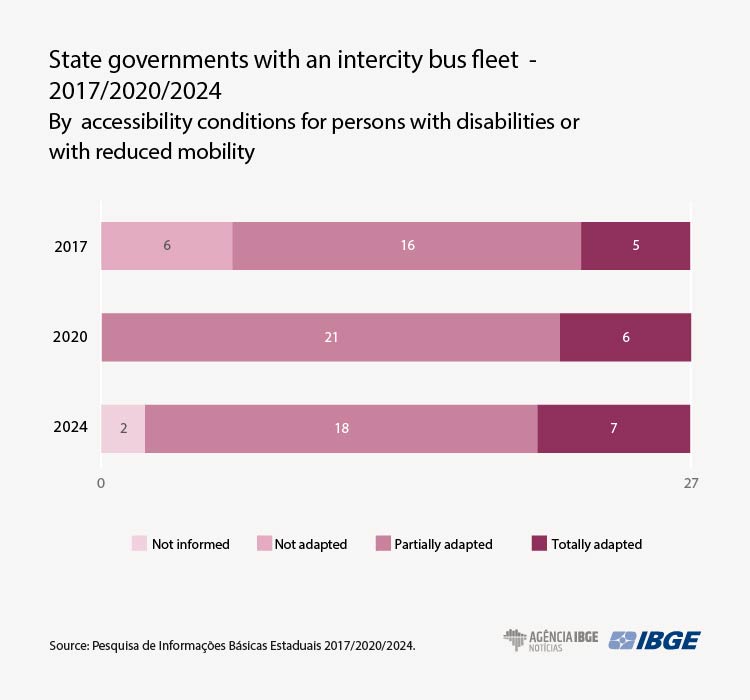
Another mode of intercity public transportation investigated was waterway, including the ferry boat, which was distributed over 16 Brazilian states. In 2017, 12 states offered this mode of transportation. All the states in the Southeast and South offered this type of transportation, as well as almost all of the North (Acre, Amapá, Amazonas, Pará, and Tocantins). The research did not inquire about accessibility and free access to this type of transportation.
Family farming boosted in 25 Federation Units
Among the programs and actions to aid small producers, Family Farming received support in 25 Federation Units (versus 23 in 2020), with the exception of Rondônia and Maranhão, which did not answer the survey. Other activities of small producers that received support were Aquaculture (23, versus 19 in 2020) and Organic Agriculture (23, versus 20 in 2020), followed by Community Garden Production (21 versus 20 in 2020) and Fishing Incentives (19 versus 17 in 2020). Ceará had support actions for family farming exclusively. Fifteen states already had ongoing programs for all actions to stimulate small producers: Acre, Amazonas, Pará, Amapá, Piauí, Rio Grande do Norte, Paraíba, Pernambuco, Alagoas, Bahia, Rio de Janeiro, São Paulo, Paraná, Santa Catarina, and Mato Grosso do Sul.
Programs to boost agricultural industry existed in 25 of the 26 responding Federation Units in 2024, with the exception of Rondônia, which did not answer the survey, and Roraima. In 2020, there were 26 Federation Units. Promotion or support for festivities occurred in all 26 responding FUs. Awards or recognition for the best producers, in 2024, occurred in 18 FUs, more widespread than in 2020 (16).
Among the 26 responding Federation Units, 25 had at least one Program or Action to Facilitate Access to Agricultural Inputs in 2024. The exception was Rondônia, which did not provide information, and Rio de Janeiro. Supply of Seeds (24), Seedlings (22), and Fertilizers (16 states) were the most widespread ones, repeating the 2020 result. All the 26 FUs reported some form of assistance aimed at providing machinery to agricultural producers, as in 2020. Programs or actions to prevent climate problems in the agricultural sector were found in 24 FUs, versus 21 in 2020.
Some social program or action aimed at agricultural producers was reported by all 26 responding FUs, with 25 having a Rural Education Program (except for Espírito Santo). Twenty-two states promoted handicrafts in rural communities, 17 had actions for health or hygiene purposes, and 12 had food distribution actions.


